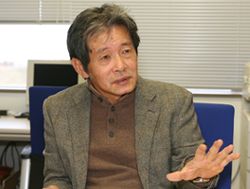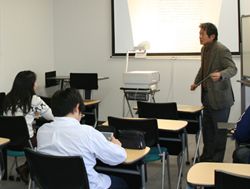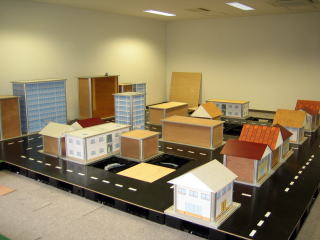| This course mainly focuses on communication
skills for the graduate students of the Master's Program.
This is a practical course that requires class participation.
The first half of the course will be devoted to developing
basic skills such as acquiring proper speech speed and finding
keywords in newspaper editorials. During the latter half of
the course, students will make presentations of their research
themes and also chair mock academic meetings. They will learn
about eye contact, posture, and proper gestures while making
presentations. The evaluation will be made based on how much
students are willing to utilize what they have learned in
class and how long they are willing to keep practicing what
they have learned. |
 |
|
 |
| In this course, doctoral students will be exposed
to various cases and acquire necessary skills to become a
leader. Students should know that leadership does not necessarily
mean power; it is rather a role. Even a president is a member
of society, and a leader is only a leader in certain relationships
such as among colleagues, customers and in his society. Guest
lecturers will give lectures on personal experiences as a
leader. |
 |
|
 |
| Are you comfortable
with papers written in English with lots of numerical formulae? |
It is necessary for young aspiring researchers
to be able to write papers in English. However, it is very
hard for Japanese researchers to write perfect English. It
will suffice for students to write English well enough for
translators to proofread. In the 'DEGEIKO' course, students
will take semi-private English writing lessons. They translate
science, technology, culture, social issues and other topics
every week, and submit the translation via e-mail.
Each translation will be reviewed and commented on. Participants
need not feel awkward It is not necessary to feel awkward
because we do not expect our students to write perfect English.
The purpose of this course is to help our students get accustomed
to writing in English. |
  |
|
 |
| Robocity
at Kyushu Institute of Technology |
| 'Robocity' is a miniaturized futuristic city
where the small humanoid robot named 'With' is introduced
to an environment with various objects and surroundings. It
is an experimental city where many kinds of robots do complicated
tasks. The city consists of two different fields: park field
and city field (5.5m2 each). There are small objects such
as traffic signals, railroad crossing, trees, benches etc.
on the fields. |
 |
The fields are flat and strong enough for people
to walk around on them. The fields are easy to arrange and
to change the surroundings. For example, it is possible to
build a maze on the field. By installing an RF-ID in the objects
such as buildings or obstacles, it becomes possible to embed
information about these objects. By installing an RF-ID in
the floor, it becomes possible to read the position of the
robot using the position reader installed in the robot.
The two-dimensional motion captures installed in the ceilings
can measure the coordinates of the robot. |
-
-
-
-
- |
Playing hide-and-seek
Playing tag
SLAM
Reinforcement learning of identifying its positions
Go exploring into a maze |
|
|